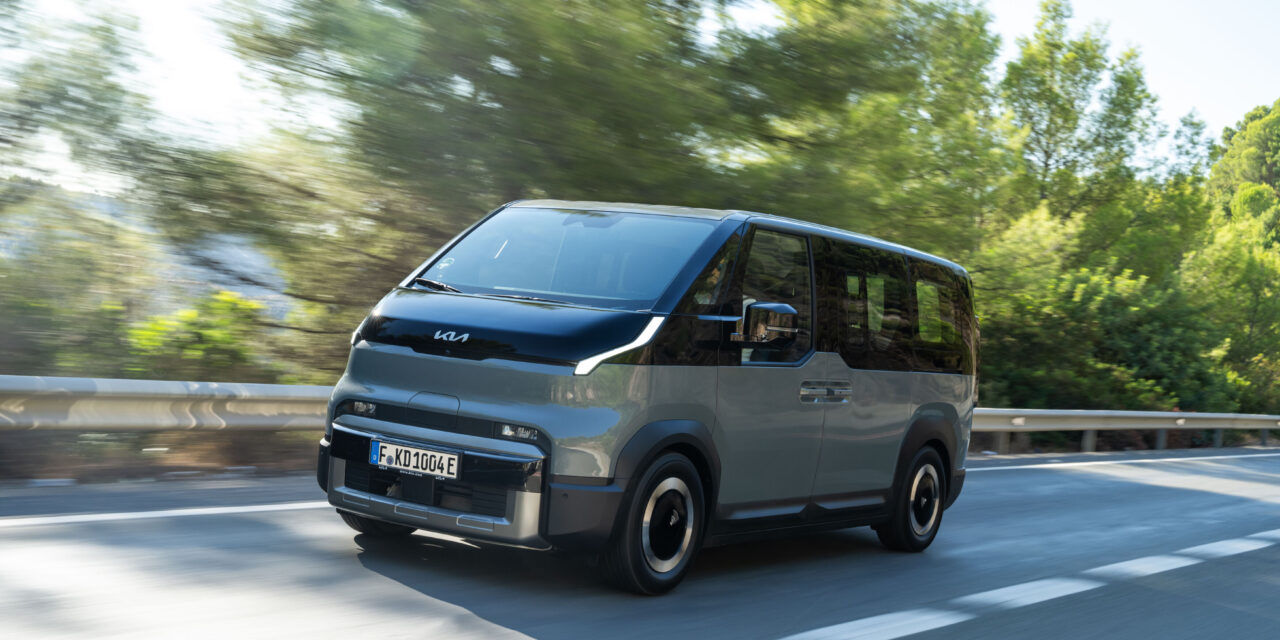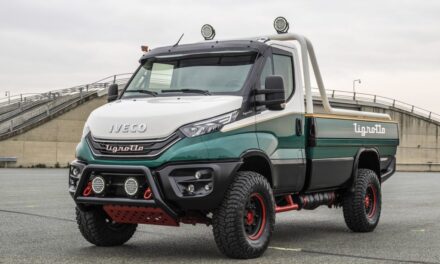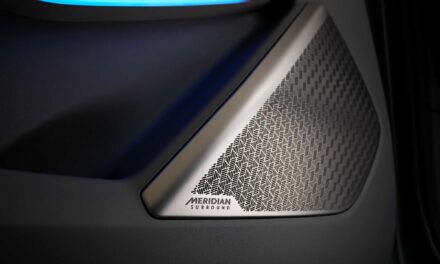- Designed from the ground up, all-electric PV5 is Kia’s first dedicated eLCV (electric light commercial vehicle)
- Strategically positioned between small and medium segments
- Modular architecture supports multiple body types, from Cargo and Passenger to specialised conversions
- Convenient dimensions, including up to 4.4m3 of cargo volume (L2/H1), best-in-class loading height (419mm)
- All-electric range (AER) of up to 258 miles, ideal for short-distance urban delivery or longer regional operations
- Chassis tuned for real-world use cases to ensure a smooth, balanced ride across loading conditions
- 5.5m turning radius offers easy manoeuvring in town
- Kia PLEOS Fleet, a new Fleet Management System, Push Data API, and Android Automotive OS transform the PV5 into a connected fleet solution
- Kia targets 250,000 PBV sales by 2030; PV5 to be followed by PV7 in 2027 and PV9 in 2029
- Flexible Body System allows up to 16 variants, supporting a wide range of Passenger, Cargo and High-Roof configurations
- PV5 Passenger model offers lowest floor in class, enabling easy entry and exit for children and passengers with limited mobility
The Kia PV5 is the company’s latest Platform Beyond Vehicle (PBV), signifying the beginning of a new chapter in the light commercial vehicle (LCV) segment. However, its role goes far beyond that of a conventional van. Developed from the ground up with direct input from business customers, the PV5 embodies Kia’s PBV philosophy by combining modularity, connectivity, and adaptability in a way that sets new benchmarks for the sector.
Built on Kia’s PBV-dedicated E-GMP.S (Electric-Global Modular Platform for Service), the PV5 features a flexible body architecture with a modular, ‘building block’ assembly concept. This skateboard-style electric platform allows configuration across a wide range of body types and use cases, including Cargo, Passenger, Chassis Cab, Wheelchair Accessible Vehicle, Light Camper, and Crew Van conversions*. Unlike many electric vans that are retrofitted from ICE platforms, the PV5 has been designed from scratch, ensuring that it can adapt to the changing needs of private customers, business clients, and fleets.
“The Kia PV5 is an industry-transforming modular, flexible and conversion-ready solution that adapts to the needs of modern businesses and modern lifestyles,” said Sangdae Kim, Executive Vice President and Head of PBV Business Division at Kia Corporation. “With the PV5, we are delivering a new benchmark in PBV technology that combines practicality, efficiency and future-ready innovation, supporting Kia’s vision to lead the global shift towards sustainable, customer-centric mobility solutions.”
Kia’s PBV business
The launch of the PV5 represents a milestone in the development of Kia’s PBV business. The recently established global division underscores the company’s determination to think beyond passenger cars and establish itself as a ‘sustainable mobility solutions provider’ for both consumers and businesses. Kia’s PBV business includes a growing product portfolio, embedded in a complete mobility ecosystem that integrates electrification, modular adaptability, and connectivity.
“With our PBV business rooting itself as a central pillar of our strategy, the Kia PV5 represents the beginning of a new era,” says Marc Hedrich, President and CEO of Kia Europe. “This global unit lets us go beyond the boundaries of traditional automotive and deliver true mobility solutions as we are building a new PBV business ecosystem that will shape the way our customers move and work.”
Stable and comfortable ride
The driving dynamics of the PV5 have been developed to meet the demanding realities of everyday business use. Tuned for efficiency and long-term reliability, the chassis provides secure, predictable handling, confident braking performance, and comfort over long distances.
“Our engineers tuned the suspension around real-world use cases. Whether the vehicle is empty or carrying a full payload, drivers and passengers can count on a balanced, comfortable experience,” says Sjoerd Knipping, COO at Kia Europe. “One of the real strengths of the PV5 is that its ride remains smooth and composed even when fully laden.”
When the Cargo variant is driven empty, the suspension still feels firm and precise, while under load, it achieves a balance that gives drivers confidence. The Passenger variant provides the same secure and comfortable dynamics over long distances.
Thanks to its wide stance and low-mounted battery, the model maintains excellent balance with and without cargo. Although its tall body makes it naturally more sensitive to crosswinds, the chassis tuning ensures composure and safety at motorway speeds.
Powertrains and all-electric range
The PV5’s powertrain is engineered to deliver performance and efficiency across different passenger and business applications. A front-mounted electric motor delivers up to 120kW of power and 250Nm of torque through the front wheels.
Customers have a choice of battery options tailored to their operational needs. Both the Cargo and Passenger variants of PV5 are available with either a 51.5kWh or 71.2kWh battery. Depending on the specific configuration, the vehicle delivers an all-electric range (AER) of up to 258 miles, ensuring suitability for both short-distance urban delivery and longer regional operations. Additionally, optimised battery placement and the energy management system keep real-world usability robust. For each additional 100kg of payload there is only around a 1.5% reduction in AER.
A range of charging options
Charging performance has been optimised for business use. The PV5 supports DC fast charging of up to 150kW (10-to-80% in around 30 minutes)** to minimise downtime on the road. In future, customers will also be able to take advantage of AC charging at 22kW for flexible, everyday use. The front-mounted charging port adds an extra layer of practicality, allowing the model to be recharged without obstructing access to the cargo area.
Kia’s public charging offer, Kia Charge, is designed with flexibility in mind. At present, Kia Charge users drivers have access to almost 1,000,000 public charging points across Europe. This continent-wide coverage is supported by partnerships with leading charge point operators, including IONITY for high-power charging.
Furthermore, Kia is developing depot charging solutions for business fleets. They enable lower per-kWh costs through overnight charging, reduce reliance on public infrastructure, and can integrate with smart energy systems to maximise energy cost reductions and advance sustainability targets.
Safety through systems and structure
The PV5 comes equipped with a comprehensive suite of Advanced Driver Assistance Systems (ADAS) to support everyday driving and enhance accident prevention. Key systems include Forward Collision-Avoidance Assist 1.5, Navigation-based Smart Cruise Control, and Lane Following Assist 2 with Hands-On Detection, alongside a wide range of additional active safety features.
Structurally, the model is built on a dual-annular exoskeleton design reinforced with high-strength steel reinforcements. A multi-frame front structure, supported by a robust subframe, can absorb crash energy and disperse forces away from the passenger compartment. Additionally, the battery system is safeguarded by 180mm of ground clearance and multiple protective layers to withstand impacts from all directions.
The ultimate connected business tool
Advanced connectivity transforms the PV5 into a digital fleet solution. Each unit is designed to work within a business ecosystem to ensure that data, efficiency, and usability work together. Kia PLEOS Fleet, the brand’s new intelligent fleet hub, provides real-time visibility into every aspect of operation, including energy status, tyre pressure, predictive maintenance alerts, and driver behaviour. For fleet managers, this means fewer unplanned interruptions and more uptime, while for drivers, it translates into safer and more efficient journeys. At the same time, Kia’s new Fleet Management System (FMS) complements this system. This platform allows businesses to manage both Kia-exclusive and multi-brand fleets, with flexible options for small companies and large corporations alike.
Aligned with its commitment to customer centricity, Kia has considered the needs of customers who require direct data integration with their current systems. A Push Data API enables secure and real-time access to vehicle data within existing infrastructures, eliminating the need for retrofitting.
“From Kia PLEOS Fleet to the Push Data API, we are giving B2B clients the tools they need to integrate it into their digital ecosystem because connectivity is at the very core of our PBV strategy,” says Pablo Martinez Masip, Vice President Product and Marketing of Kia Europe and COO of Kia Connect Europe. “This makes the PV5 one part of a connected platform that grows with our customers and empowers them to work smarter and more efficiently.”
The PV5 runs on Android Automotive OS with a PBV-exclusive infotainment system and a 12.9-inch widescreen display in 16:9 format. The interface supports multitasking, allowing navigation and applications to run side by side, while essential controls like climate functions always remain accessible. For added convenience, Kia’s AI voice, a generative AI model, allows drivers hands-free control of certain vehicle functions.
Operators can install industry-specific or third-party apps from the PLEOS App Market, which will be regularly updated, without needing additional switches. Dedicated UP-FIT switches are available for controlling PBV-specific equipment, such as refrigeration units or lighting.
Durability and warranty
To create a better ownership experience, Kia has ensured that the PV5 offers customers peace of mind. The PV5 comes with a best-in-class seven-year/100,000-mile warranty. The battery pack and electric motor is covered by a separate eight-year/100,000-mile warranty in full compliance with UK (and upcoming European) regulations.
Predictive maintenance systems and modular repair solutions work together to decrease equipment downtime and lower the total cost of ownership. By leveraging the connectivity ecosystem, operators can proactively schedule maintenance activities, which helps minimise operational interruptions.
On top of that, the PV5’s body structure is purpose-built for functionality. Features like three-piece bumpers and modular rear-side garnishes are designed to be replaced independently, streamlining repairs, reducing costs, and shortening turnaround times.
What advantages does Kia’s PBV Flexible Body System offer?
The PV5 introduces Kia’s Flexible Body System, a modular design that enables diverse vehicle configurations and supports the rapid development of up to 16 variants from a limited number of assemblies. Front cabin modules are standardised, while rear-end, roof, and quarter glass components can be flexibly combined during production to create dedicated Cargo, Passenger, or High-Roof models.
The PV5 Passenger variant features the lowest floor in its class, enhancing accessibility for children and passengers. Sidestep height at the sliding doors is just 399 mm, and with the second-row seats folded, the five-seater model offers up to 3,615L of luggage volume (starting from behind the 1st row, with height up to headlining) – providing versatility for both daily use and weekend outdoor activities
The PV5 Cargo variant, meanwhile, is engineered for commercial efficiency. A low-floor design, combined with a rear step height of just 419mm, simplifies loading and unloading. Cargo volume ranges from 4.0m³ in the L1H1* model to 5.2m³ in the L2H2* model – large enough to accommodate two Euro pallets. This generous capacity makes the PV5 highly competitive with traditional car-derived vans while maximising usability for business customers.
How has Kia ensured that the PV5 provides accessible mobility for everyone?*
Kia has developed a Wheelchair Accessible Vehicle (WAV) variant of the PV5, designed to offer greater freedom and independence for individuals facing mobility challenges. It features a gently sloped side-entry ramp, universal securing systems, and a spacious low-floor layout to ensure easy access and comfortable travel.
The PV5 WAV is designed not only for wheelchair users, but also with the needs of families, caregivers, and drivers in mind – supporting inclusive, convenient mobility while enabling a seamless transition to electric transportation.
This variant demonstrates Kia’s commitment to inclusivity and versatility across its PBV portfolio, as well as its determination to serve a growing market segment shaped by rising life expectancy and aging populations worldwide.
How will Kia extend its PBV conversion strategy?*
From the outset, the PV5 has been designed for seamless conversions. At the heart of this strategy is Kia’s PBV Conversion Center, which offers certified, factory-quality conversions. Donor models are pre-prepared with non-essential components — such as seats and trim —removed, enabling certified conversion partners to easily integrate professional equipment.
To further support our global conversion partners, Kia provides access to a dedicated Conversion Portal System. This platform offers technical resources including 3D CAD Data, a Bodybuilder Manual, and homologation information, along with a Technical Hotline to ensure safe and consistent conversions worldwide[1].
When will the Kia PV5 reach customers?
Mass production of the PV5 Passenger and Cargo (Long) models is already underway at Kia’s Hwaseong EVO Plant in Korea, with additional variants scheduled to roll out sequentially.
What are the goals of Kia’s PBV business strategy?
- Launch PV7 in 2027
- Launch PV9 in 2029
- Sell 250,000 PBVs globally by 2030
- Establish a scalable, software-driven mobility ecosystem
Technical Specifications: The Kia PV5
Variant | Passenger (2-3-0) | Cargo (L2/H1) | |||
Platform | Electric-Global Modular Platform for Service (E-GMP.S) | ||||
Length (mm) | 4,695 | 4,695 | |||
Width[2] (mm) | 1,895 | 1,895 | |||
Height (mm) | 1,899 w/o antenna3 | ||||
Wheelbase (mm) | 2,995 | 2,995 | |||
Battery (kWh) | 71.2 | 51.5 | 71.2 | 51.5 | |
Power (kW)[3] | 89.4 | 120 | 89.4 | 120 | |
Range (miles, WLTP) | 256 | 258 | |||
Charging (H:min) | DC fast charging (10-80%) | 0:30 | 0:30 | ||
AC charging (10-100%) | 6:30 | 4:45 | 6:30 | 4:45 | |
Tyres | 215/65R16 | ||||
0-62mph (seconds, w/ 71.2kWH battery) | 10.6 | 12.4 | |||
Turning radius (m) | 5.5 | ||||
Cargo space (L, VDA) | 1,330 (behind 2nd row) 3,615 (with 2nd row folded) | 4.4m3 | |||
Payload (kg) | – | 690 | 790 | ||
Convenience features*** | powered DR and PR seats, heated / ventilated seats, wireless charger, heated steering wheel, multiple cabin storage options, in-cabin V2L | heated DR/PR seats, heated steering wheel, multiple cabin storage options, V2L in cargo area, floor lashing points | |||
ADAS | Forward Collision-Avoidance Assist 1.5, Navigation-based Smart Cruise Control, and Lane Following Assist 2.0 with Hands-On Detection, Surround View Monitor | ||||


















